Free shipping on orders over $100
30% OFF on trending items
25 Common Cat Sleeping Positions
25 Common Cat Sleeping Positions and How to Interpret Them Like a Cat Whisperer
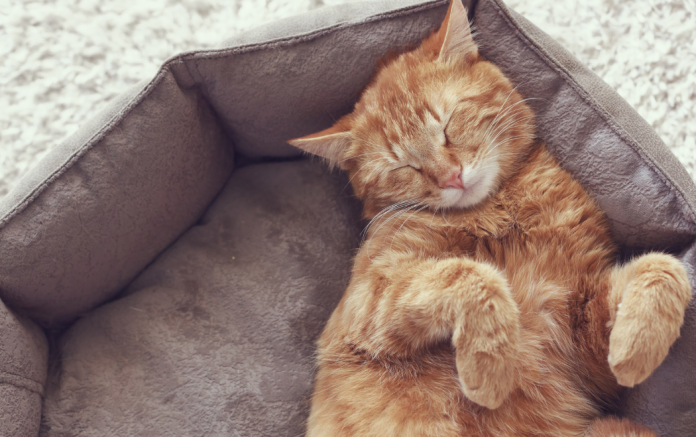
Cat sleeping positions can be as weird and wonderful as the mysterious furry creatures themselves. In fact, where and how your cat chooses to sleep can give you a glimpse of the inner workings of your furkid’s mind.
From warm and secure sleep body language to ready-for-action ones, we cover common interpretations surrounding the ways your cat snoozes. If you’re concerned about a sick cat, we’ve included some advice about what to look out for as well.
Read on to discover the 25 most common cat sleeping positions and what they mean!
Affectionate Cat Sleeping Positions
Cats may sometimes get a bad rap for being aloof and solitary, yet many of them tend to sleep with their owners or other household pets they may feel bonded to. This can typically be seen as a sign of trust, companionship and comfort.
Some cat breeds that are known to be cuddly include Ragdolls, Maine Coons, Ragamuffins, Siamese and Burmese.
1. At Your Feet
Cats usually take on this sleeping position as a sign of affection, being able to stay close to you, keep you warm and safe at the same time. By being at your feet, they have the chance to alert you if any threats come creeping in at night. This is an important instinct for prey animals in the wild, to protect themselves and each other from predators.
The foot of the bed is also typically a great vantage point for your cat and provides them an easy route of escape if they need to spring into action. Plus, they get additional warmth and comfort from your body heat too!
2. Between Your Legs
Another position they may take to keep warm is between your legs, typically indicating that they feel safe and comfortable with you. Think of yourself as a nice, warm enclosed space for your floof, much like a box or a cat bed. The security you provide may even allow them to fully let their guard down and go into deep sleep!
They may also choose this resting place to comfort you and show you affection, mark you as their territory or to have a clear escape route near the foot of your bed.
3. Next To You
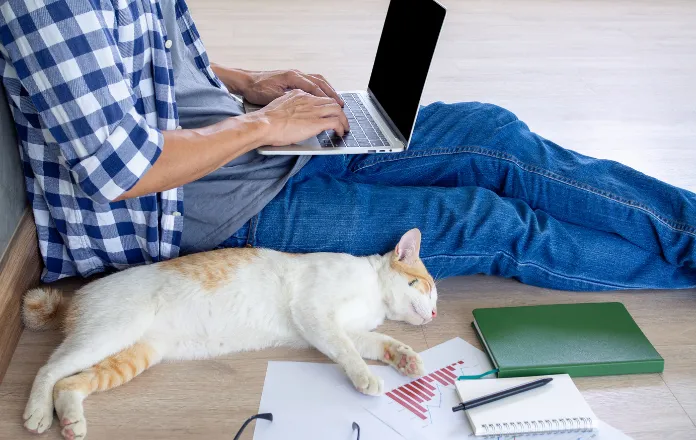
Your cat may lay next to you when sleeping if they’re looking for security. It usually means that they trust you and take comfort in your presence. They may even face their backs to you so they can watch the environment and keep you both safe – aww!
Some cats may lay next to their pawrents with some buffer area in between – so close yet so far, we know. These kitties may just prefer to have some personal space while enjoying their owners’ presence, nothing personal (probably).
4. On Your Chest
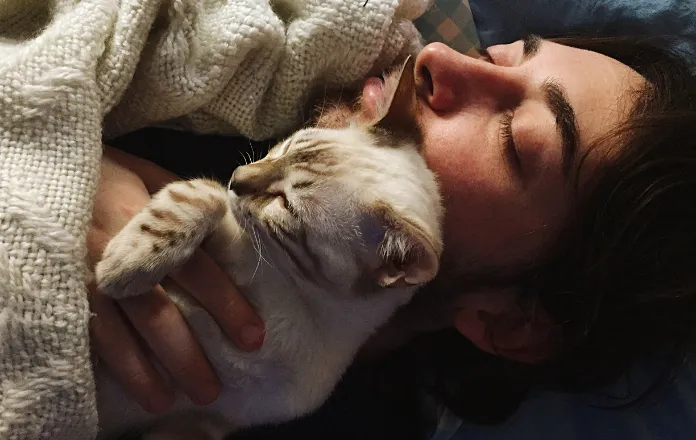
It’s adorable when cats sleep on their humans, be it on their stomach, lap, or chest. They may be looking for security and warmth, or making a clear statement by marking their territory.
If your furkid is sleeping on your chest, she may also be seeking comfort from your scent or the sound of your heartbeat and breathing. She may also enjoy being close to your mouth if she finds your voice comforting. Plus, sleeping on you puts her in a prime position to wake you up once she gets hungry.
5. On Your Head
Cats sometimes engage in ‘pillowing’, where they use other trusted cats as a soft, cozy spot to lie against during naptime. If your cat sleeps on your head, she may just be looking for that. It’s also the best body part for them to sleep against if they want to avoid any tossing or turning you may do at night.
Other reasons your cat may do this include keeping warm, being close to you, and showing affection. She may also simply enjoy the scent of your hair.
6. With A Dog
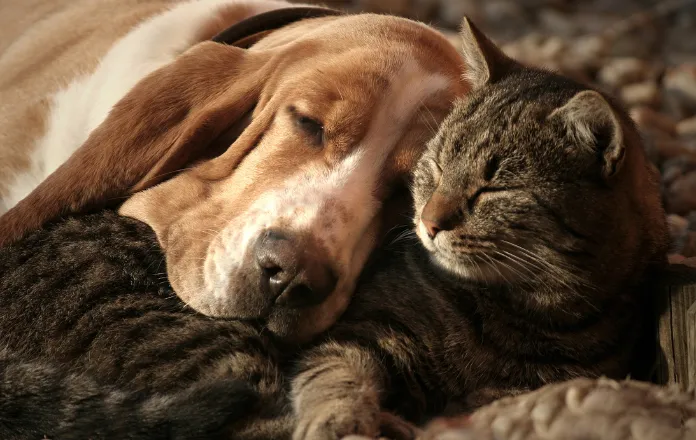
Contrary to what popular media may have you believe, cats and dogs can get along in a household, with the proper introductions. These need to be done patiently and gradually to allow your pets to grow comfortable with each other and get accustomed to each other’s body language.
If your cat is sleeping with your dog, it likely indicates that they trust each other, suggesting you’ve done a good job fostering their bond. This behavior usually means they seek companionship while they rest.
7. With Other Cats

Kittens often cuddle up together in a cozy pile to stay warm and safe, a habit that can continue into adulthood along with behaviors like kneading and purring.
If your adult cats sleep together, it’s likely they enjoy each other’s company and have formed a bond. They might seek each other’s proximity for companionship and comfort, even if they’re only slightly touching.
On the other hand, not all coexisting cats are close. Some may merely tolerate each other, choosing to sleep on the same bed as a way to express a basic acceptance, essentially saying, “I don’t hate you.” Such are the complex social lives of cats!
Ready-for-action Cat Sleeping Positions
Felines are natural born hunters and they show these tendencies even if they’re indoor cats. These natural instincts are reflected by some common sleeping positions that allow them to spring into action anytime they sense prey or predators nearby.
8. By the Front Door
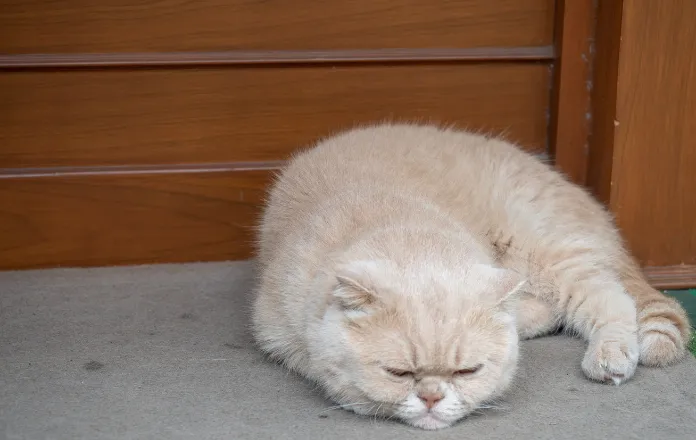
If your feline friend sleeps by the front door, they’re most likely just curious about what’s going on outside. Sitting by the door gives them access to all the interesting noises coming from the outside world. If your cat is an outdoor cat (or a curious indoor one), they may also be plotting their escape out of the house, so beware!
Your cat may also be waiting for you to come home and wondering why you keep going into the outside world. Or, they could simply be bored and in need of some interaction – perhaps a cat toy could help?
9. Eyes Half Open
It’s normal for some cats to sleep with one eye open, or both eyes half open. This is because of their natural instinct to look out for danger as they rest. A napping cat typically remains alert and conscious of their surroundings to keep themselves safe.
Though uncommon, a cat sleeping with open eyes may sometimes be a sign of injury or illness, warranting a visit to the vet. Other symptoms to look out for include eye discharge or swelling, a visible third eyelid when awake, squinting, seizing or twitching.
10. Perched On Furniture
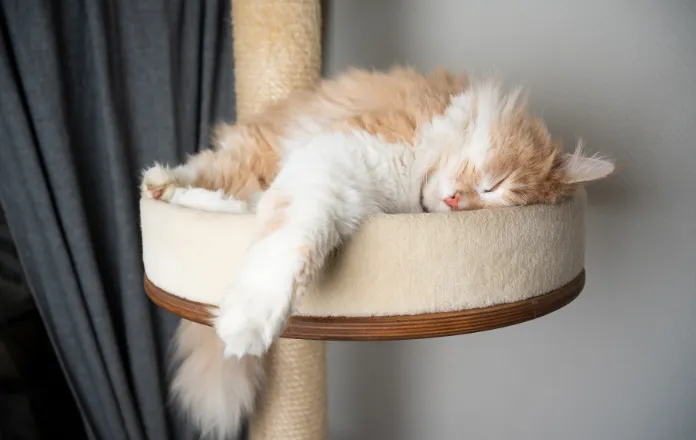
Cats may sleep perched on furniture like your bed’s headboard or dining table to get a good vantage point of the entire room. This is to appease their inner hunter, keeping an eye out for any potential prey in the home. If they’re sleeping uncomfortably close to the edge of the surface, they may be making sure they can pounce at any time.
Conversely, cats that sleep on top of tall furniture like a fridge or a cat tree may be seeking refuge from potential predators. Simply put, elevated areas of the house allow sleeping kitties to feel safe and in control of the environment around them.
11. The Loaf
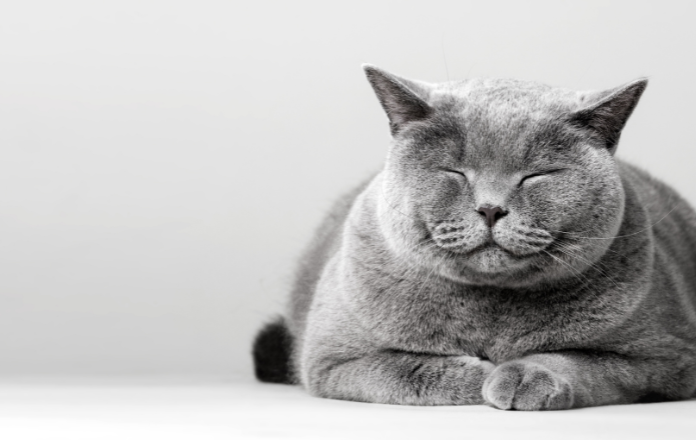
Most cat moms and dads should be familiar with the iconic loaf (or baguette) position, where a cat sits upright, with their paws tucked neatly under their bodies.
When a cat sleeps in this position, they’re usually keeping their vital organs safe and warm as they sleep. It’s also a great position for kitty to stay alert while snoozing, where she can easily get on her feet and use her claws if she senses any danger.
12. The Monorail
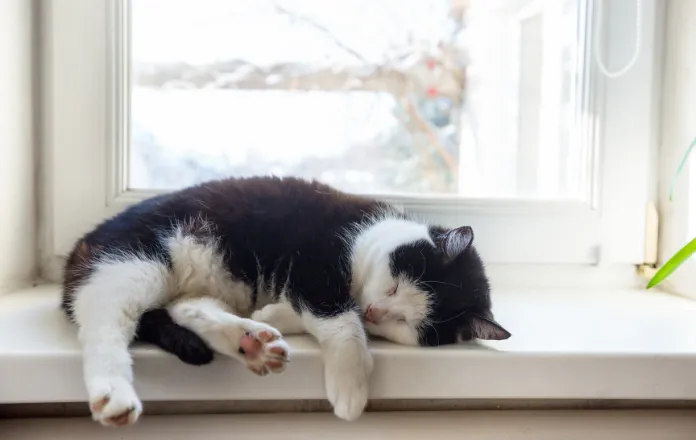
The monorail position occurs when a cat sleeps on narrow surfaces such as the arm or back of a couch, often with one or more legs hanging off. This behavior is reminiscent of wild cats who sleep on tree branches.
Adopting this position allows cats to feel secure and comfortable, while also remaining ready to spring into action if needed. Additionally, if you frequently use the couch, your cat may choose this spot to stay close to you.
Sleeping Positions that Indicate Cat Trust
In the wild, cats often sleep with their bellies concealed to protect their vital organs from predators. This protective instinct persists in domestic cats. Therefore, when your cat sleeps with its belly exposed, it usually signals trust.
However, this display of vulnerability isn’t always an invitation for belly rubs or paw touching—proceed with caution!
13. Belly Up
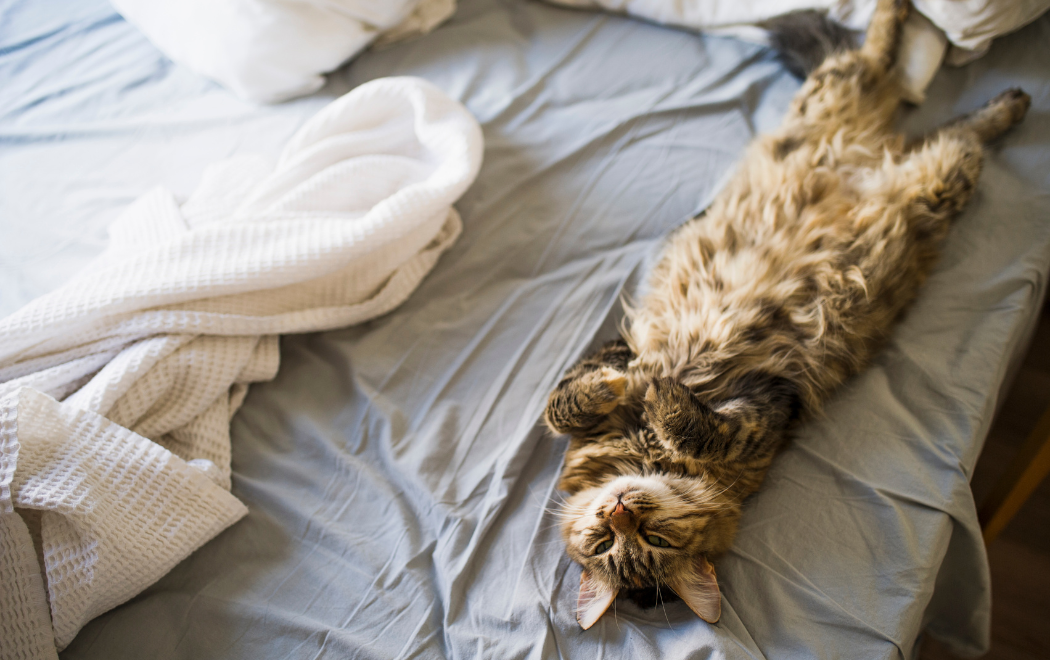
Arguably one of the cutest resting positions is when a cat sleeps on their backs, typically with legs wide open and their front paws limp at the chest area. A cat sleeping with their belly exposed is usually a great sign that they trust you and are feeling relaxed and confident. daftar sbobet88
14. Laying on Their Side
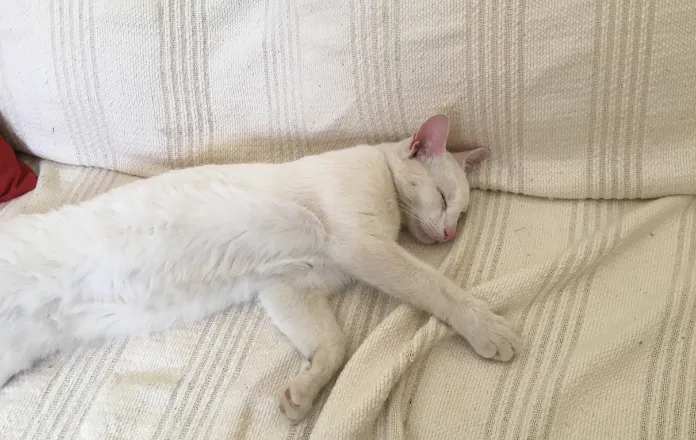
One of the most common sleeping positions for cats is on their side with legs extended. When your cat adopts this pose and exposes her belly, it often indicates a deep trust in her surroundings. This position not only offers comfort but also prepares her to spring into action quickly if needed. While it appears deeply relaxed, this stance allows your cat to remain alert, ensuring she feels secure enough to doze lightly.
15. Sleeping Upright
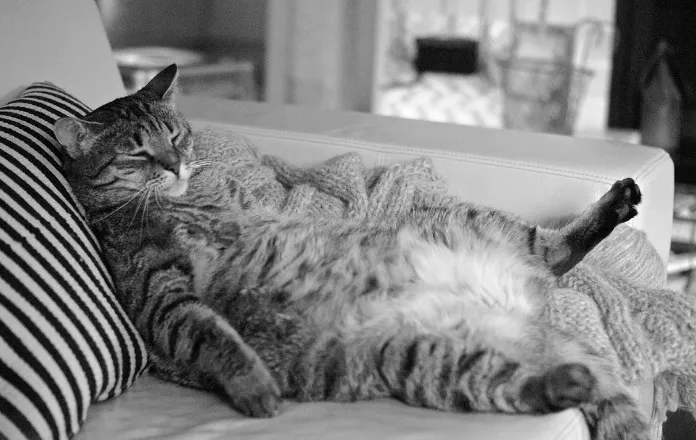
A cat sleeping upright may seem a little strange and uncomfortable but hey, if it works, it works. This position typically comes with an exposed belly, which means your cat feels safe and trusts you and their environment.
Cats may sometimes sleep like this to get easy access to groom their bellies between naps. They may also do this to give additional support to their back muscles, or if they want to stay alert in case of any opportunities to hunt prey.
Cat Sleeping Positions to Monitor When They Are Unwell
Here are some sleeping positions cats may adopt if they’re feeling unwell or experiencing pain. While these positions alone don’t confirm illness, they should prompt you to watch for other symptoms like fatigue, loss of appetite, changes in behavior, and labored breathing.
If you suspect your cat may be unwell, do contact your vet for professional medical advice.
16. By the Water Bowl
Your cat may be sleeping beside the water bowl because it happens to be a comfy spot in the house. However, it may also be a sign that your cat is dehydrated, which you can check by gently pinching the skin between their shoulders. If the skin doesn’t quickly drop back after you release it, they may be dehydrated.
17. Face Down
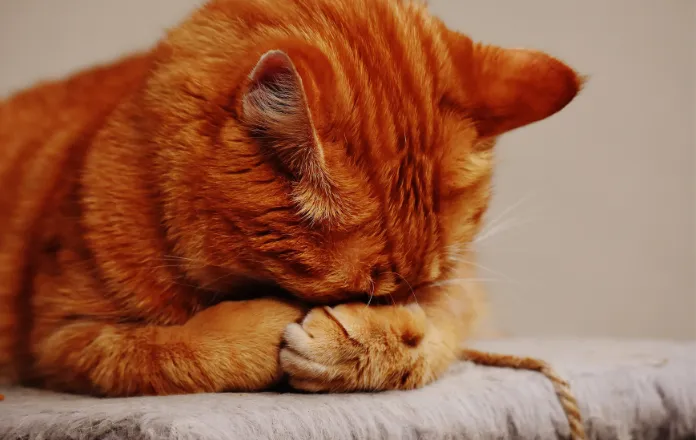
A cat sleeping face-down might be seeking solitude, dodging bright light, or keeping their nose warm. They could also be worn out from a day filled with typical feline antics, or they might just find the position especially comfortable.
However, this posture could also be a sign of illness, particularly if your cat presses their face to the ground while hunched over or adopts a loaf position. In such cases, it’s important to monitor for other symptoms like:
- Decreased appetite
- Lethargy
- Seizures
- Head tilt
- Loss of consciousness
- Weakness or uncoordinated walking
18. In the Litter Box
If your cat suddenly starts sleeping in the litter box, it’s important to get it checked by a vet as it may indicate an underlying medical condition. She may be suffering from urinary or digestive issues like constipation, diarrhea, urinary tract infection, or bladder blockage.
Older felines may also choose to sleep here for easy access to their litter if they have arthritis. If they suffer from dementia or cognitive dysfunction, they may also mistake the cat litter box for their other resting places.
It’s also possible that your cat may just be looking for a safe hiding spot. However, the behavior shouldn’t be encouraged as it may give rise to medical issues like eye or ear infections.
Warm and Secure Cat Sleeping Positions
Here are some default sleeping positions you may find your cat in if they’re trying to keep warm and safe. Your furry friend may be sleeping in these positions more regularly if they’re feeling anxious about potential dangers, or cold during chilly seasons.
19. Curled Up in a Ball
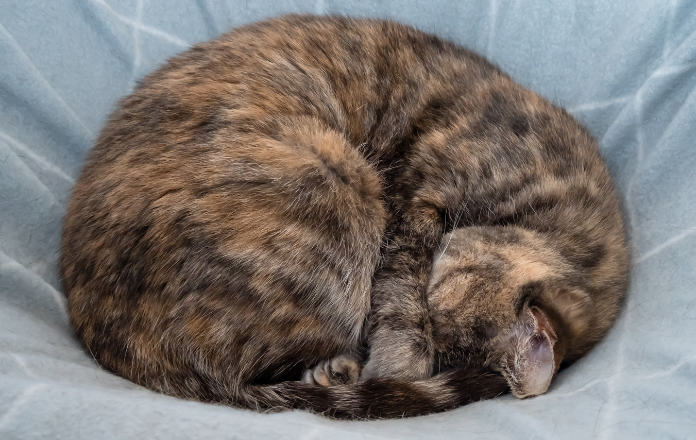
Cats are commonly found curled up in a ball or crescent, with their noses to their tails. This position keeps their vital organs tucked away and well protected, which would keep them safe from predators in the wild. It’s also a great position for keeping warm and comfortable while sleeping.
An adorable modified version of this is the cat shrimp pose, where curled up cats stretch their legs out, resembling an uncooked shrimp. Why? They probably just find it really comfy!
20. In a Box
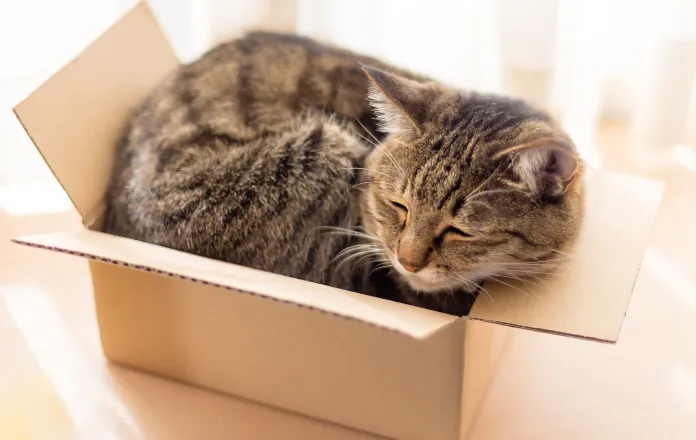
Cats tend to love enclosed spaces as it helps them feel safe and secure against any predators or external dangers. Thus explains their love for boxes – safe havens where they can observe their surroundings and not be seen, supposedly.
Your cat is likely sleeping in a box to feel relaxed while resting, and to also keep herself warm. Furthermore, cats that love squeezing into boxes that are way too tiny for them typically do so for an added feeling of security. Think: an infant that enjoys being swaddled.
21. Paws Over Eyes
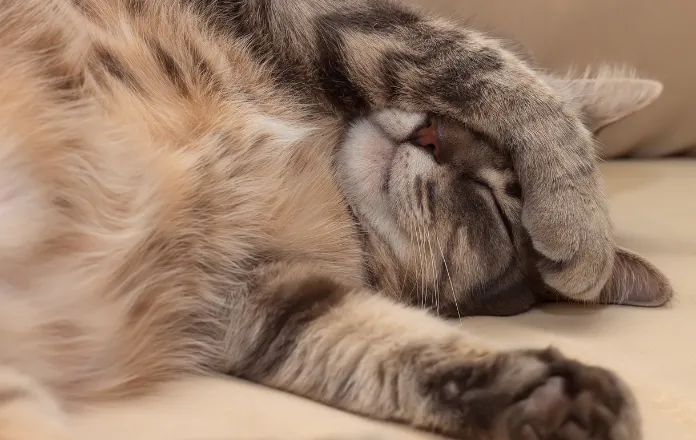
This adorable pawsition typically allows cats to block light out of their eyes, or sometimes irritants like dust or pollen. Covering their eyes with their paws also helps to keep them feeling warm, safe and snuggly.
They could also be telling their hoomans or other housemates that they’d prefer to be left alone as they snooze.
22. Under the Bed
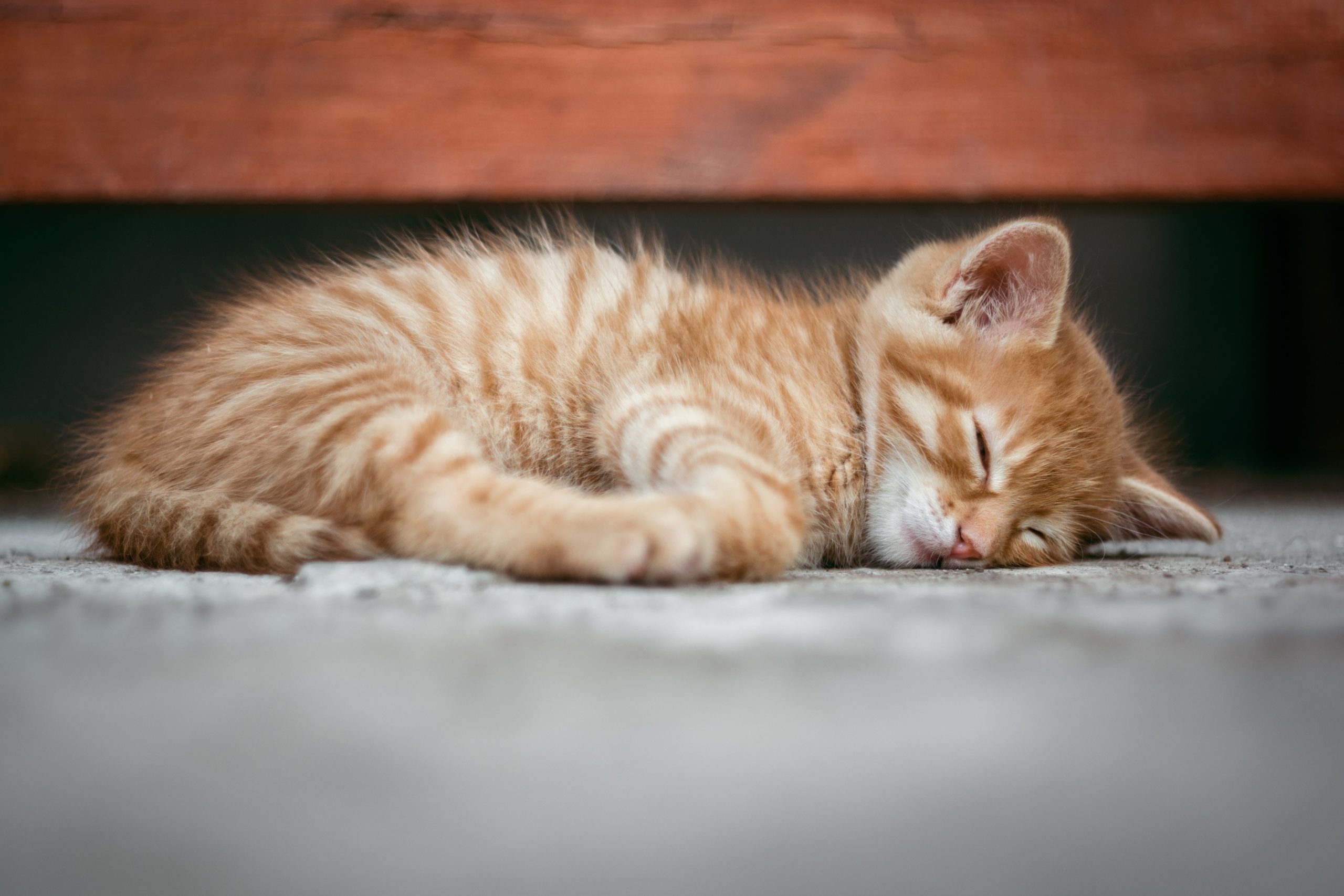
It’s normal for some cats to enjoy sleeping under their hoomans’ beds as it tends to be dark, warm, cozy and quiet. However, some cats may also do this if they’re feeling scared or anxious, and they need somewhere safe and secure to hide away. Stress relief products for cats may be helpful to calm your kitty in these situations.
As they typically do this to get away and be alone, it’s good to keep an eye out for other behaviors such as their eating, drinking and litter box habits to rule out illnesses or pain.
SHARE



